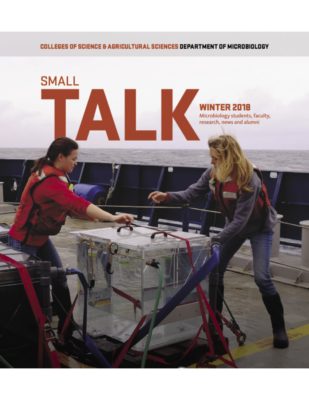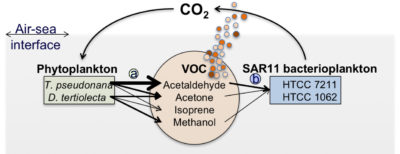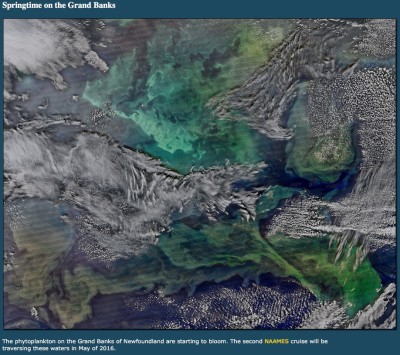Eric’s work on VOCs produced by a diatom. Many of these VOCs are consumed by SAR11, causing the diatom to work 20% harder to keep up with the bacterial demand! Eric compared VOC production by T. pseudonana in monoculture and in co-culture with HTCC1062. He used PTR-ToF/MS and a clever experiment using a hydrocarbon trap to show the impact of VOC consumption on carbon fixation rates. Published in Environmental Microbiology.
Category: VOCs
Here’s our Department’s new newsletter! Cleo and I made the cover, and there’s a nice little blurb on the lab’s work inside.

Congratulations to post doc Cleo Davie-Marin who received an award to study the volatile organic carbon metabolome. This award will help her to develop a new incubation technique to investigate VOC “fingerprints” produced by the abundant cyanobacterium, Synechococcus sp. This work builds on the momentum developed through her mentorship of undergraduate researcher, Duncan Ocel. Duncan and Cleo are an adventurous team, both scaling rocks and seeking other adventures whenever not in the lab, where they are also exploring new territory.
 Our most recent paper on VOC cycling in the surface ocean was just published in Limnology and Oceanography. Phytoplankton produce different profiles of VOCs depending on species and some bacterioplankton, including the ubiquitous and abundant SAR11 bacteria consume these compounds. We designed new incubation chambers and attached these chambers to a PTR-MS to make real time measurements of VOC production and consumption . This work was a collaborative effort with atmospheric physicists at NOAA. Halsey et al. 2017 doi: 10.1002/lno.10596
Our most recent paper on VOC cycling in the surface ocean was just published in Limnology and Oceanography. Phytoplankton produce different profiles of VOCs depending on species and some bacterioplankton, including the ubiquitous and abundant SAR11 bacteria consume these compounds. We designed new incubation chambers and attached these chambers to a PTR-MS to make real time measurements of VOC production and consumption . This work was a collaborative effort with atmospheric physicists at NOAA. Halsey et al. 2017 doi: 10.1002/lno.10596
A new paper from the Giovannoni lab was published this week in Nature Microbiology on the unexpected discovery that SAR11 bacteria produce methane thiol and DMS from DMSP metabolism. Our role on this paper was to measure real time production of these compounds using PTR-MS. Overall, the research described in this paper combined culturing, biochemistry, genomics, proteomics, and atmospheric chemistry to reveal the remarkable activities of this tiny, abundant, and remarkably impactful bacterium.
Sun et al. 2016_Nat_Microbiol.
In just one week Cleo and Kelsey will be boarding the R/V Atlantis for a month in the North Atlantic, coinciding with the spring phytoplankton bloom. Cleo will be operating the PTR-MS again, measuring rates of volatile organic carbon production. This will be Kelsey’s first research cruise. She will be providing technical support to several other research groups ~ an excellent opportunity for her to interact with other research scientists, particularly those interested in the dynamics of higher trophic levels, because those grazers are of special interest to her. NASA has a new video showing the view from the aircraft side of NAAMES.

